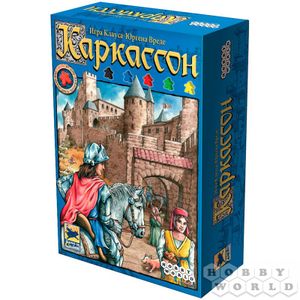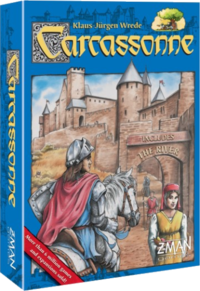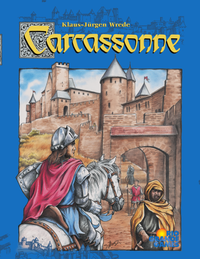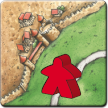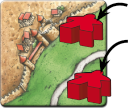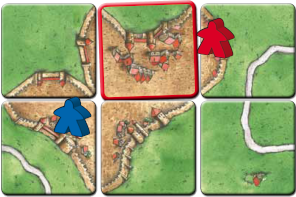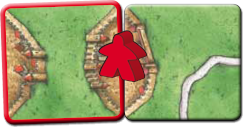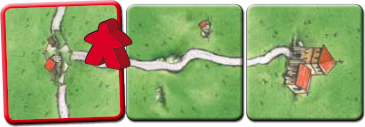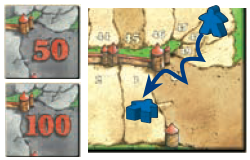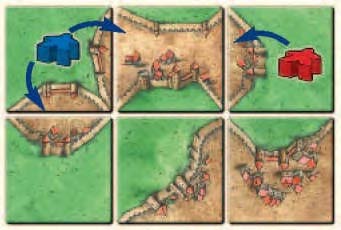Базовая игра (1-е издание)
 |
Вы читайте правила для этого дизайна квадратов. |
 | Прочтите следующие правила, если ваши квадраты выглядят так. |  |
| Если ваши квадраты имеют иной дизайн, тогда выберите игру из Спин-оффов. |  |
| Hobby World | Z-Man Games | Rio Grande Games |
Общая информация и комментарии
Первоначально издана компанией Hans im Glück в 2000
Стратегическая игра Клауса-Юргена Вреде
Каркассон — старинная крепость на юге Франции, основанная ещё во времена Римской империи. Это величественное каменное сооружение прославилось во времена Альбигойских войн (1209–1229 годы), когда замок Каркассон стал одним из оплотов народа Лангедока и выдерживал продолжительную осаду войска крестоносцев.
Состав
- 72 картонных квадрата, на которых изображены участки городов и дорог, поля, перекрёстки и монастыри
- 40 фишек подданных 5 цветов (по 8 каждого цвета, одна из которых используется на дорожке подсчёта):
40 фишек подданных 5 цветов
![]() Вопрос: Слишком мало подданных — мы играем неправильно или их действительно слишком мало?
Вопрос: Слишком мало подданных — мы играем неправильно или их действительно слишком мало?
- дорожка подсчёта очков (максимальное число очков не ограничено; если вы набрали больше 50 очков, пустите свою фишку по второму кругу)
- правила игры
Правила
Об игре
В «Каркассоне» вам предстоит составлять карту средневекового княжества из квадратов с нарисованными на них дорогами, городами, полями и монастырями. На эти дороги и поля, в монастыри и города вы будете отправлять своих подданных, чтобы впоследствии получить за них победные очки. В ходе партии один из игроков может сильно вырваться вперёд, однако победа присуждается только по результатам финального подсчёта очков.
Подготовка к игре
- Положите стартовый квадрат посередине стола лицом вверх.
- Перемешайте все остальные квадраты и сложите их лицом вниз несколькими стопками в месте, удобном для всех игроков.
- Положите на край стола дорожку подсчёта победных очков.
- Каждый игрок берёт все 8 фишек одного из цветов. 7 подданных он оставляет у себя в запасе, а одну фишку ставит на деление «0» дорожки подсчёта.
- Выберите случайным образом игрока, который начнёт игру.
Ход игры
Игроки ходят по очереди, по часовой стрелке, начиная с первого игрока. Каждый ход протекает по одной и той же схеме:
- Игрок берёт один из закрытых квадратов и присоединяет его к уже выложенным на стол.
- Игрок может выставить своего подданного на только что сыгранный им квадрат.
- Если только что сыгранный квадрат завершил строительство дороги, города или монастыря, за этот объект начисляются очки.
1. Как сыграть квадрат
Вытяните один из квадратов, лежащих рубашкой вверх. Переверните квадрат и покажите его всем игрокам. Они могут предложить вам, куда его лучше выложить, однако вы не обязаны следовать их советам. Присоедините вытянутый квадрат к уже выложенным на стол. При этом должны соблюдаться следующие правила:
- Новый квадрат должен хотя бы одной стороной соприкасаться с уже выложенным ранее.
- На стыке квадратов все дороги должны переходить в дороги, поля — в поля, а города — в города (выкладываемая из квадратов «географическая карта» должна оставаться цельной).
Если вы не можете выложить вытянутый квадрат согласно правилам, уберите его в коробку и возьмите другой. Не забудьте перед этим поинтересоваться у соперников — возможно, вы просто не заметили, куда можно выложить этот квадрат.
На иллюстрациях только что выложенный квадрат обозначен красной рамкой.
2. Как выставить подданного
При желании вы можете выставить своего подданного на только что сыгранный вами квадрат. Это делается по следующим правилам:
- На каждом ходу вы можете выставить только 1 подданного.
- Этот подданный должен быть взят из вашего запаса, а не из числа помещённых вами на карту ранее.
- Вы должны определить, на какую часть квадрата ставите подданного:
- Кроме этого, вы не можете поместить подданного на дорогу, на поле или в город, если где-нибудь на этих же дороге, поле или в городе уже находится другой подданный (ваш или вашего соперника).
Совет: выставляйте крестьян «плашмя», а не «стоя» — так их будет легче отличить от рыцарей, монахов и разбойников.
Если в запасе у игрока не осталось подданных, ему придётся выставлять новые квадраты пустыми и ждать, пока какая-либо из выставленных фишек вернётся в запас.
If any feature was completed through the placement of the tile, it must now be scored. If not, the player’s turn is over, and it is the turn of the next player on the left.
![]() Вопрос: We have difficulty deciding when a placed tile represents a new city or belongs to one already being built.
Вопрос: We have difficulty deciding when a placed tile represents a new city or belongs to one already being built.
![]() Вопрос: On cloister tiles, are we allowed to deploy a follower on the surrounding field segment?
Вопрос: On cloister tiles, are we allowed to deploy a follower on the surrounding field segment?
3. Score completed roads, cities or cloisters
A completed road
A road is completed when the road segments on both sides end in a crossing, [2] a city segment, or a cloister, or when the road forms a closed circle. There is no limit to the number of road segments which can lie between these endings.
A player who has a thief on this completed road scores as many points as the road is long, decided by counting the number of tiles.
Whenever points are scored, they are immediately recorded on the scoreboard (more on this in the section about the scoreboard).
![]() Вопрос: Can a road end in nothing?
Вопрос: Can a road end in nothing?
![]() Вопрос: How are the road segments between T-junctions scored? Are the horizontal segments (on top of the T) also ends, or do these count as straight roads that have to be completed elsewhere?
Вопрос: How are the road segments between T-junctions scored? Are the horizontal segments (on top of the T) also ends, or do these count as straight roads that have to be completed elsewhere?
A completed city
A city is completed when its segments are fully encompassed by a city wall and there are no gaps within the city.[3] There is no limit to how many segments a city may contain.
A player who has a knight in a completed city scores 2 points for every city segment. [4] Every pennant (banner / shield symbol) scores an extra 2 points. Note that a pennant only affects the city segment it is in, not the whole tile (if there is more than one segment on a single tile).
What happens if there are several followers on a completed road or in a completed city?
Through the wily placement of land tiles it is quite possible for several thieves to be on a road, or for several knights to occupy a city.
The points are then scored by the player with the most thieves or knights. In the case of a draw, all players involved score the full number of points.
A completed cloister (monastery)
A cloister is completed when it is surrounded by eight land tiles. The player who has a monk in the cloister immediately scores 9 points—1 point for every land tile.
Returning followers to their owners
After a road, city, or cloister has been completed and scored – and only then – any thieves, knights, or monks involved are returned to their owner. From the next turn onwards, the player can then use them again in whatever role he or she chooses.
It is possible to deploy a follower, score immediately, and have the follower returned, all in the same turn. In this case, you must use the following order: [5]
- Complete a road, city or cloister with the new tile.
- Deploy a thief, knight or monk.
- Score the completed road, city or cloister.
- Return the thief, knight or monk to your supply.
![]() Вопрос: If a player draws a tile with two city segments and completes a small city, earning 4 points, can he or she then deploy a follower to a new city segment in the same turn?
Вопрос: If a player draws a tile with two city segments and completes a small city, earning 4 points, can he or she then deploy a follower to a new city segment in the same turn?
Farms
Several connected field segments form a farm. Farms and field segments are not scored during the game. They serve only as places to deploy farmers; the owner of the farm only scores points at the end of the game. As such, farmers remain on the farm for the duration of the game and are never returned to their owner! [6] In order to make that clear, the farmers should be laid on their backs.
Farms are separated from each other by roads, cities and the edge of the playing field – this is important during the final scoring. [7] [8]
The scoreboard
Any points scored should be recorded on the scoreboard immediately. The board is a track of fifty fields that can be lapped many times. When the field "0" is reached or passed the player takes a point tile (from ![]() Таверны и соборы) and places it in plain view of all other players, with the number "50" face up. In this way it is clear to all that the player has already scored 50 points or more [9] If the player reaches or passes the field "0" again, they should turn the point tile over so that the number "100" is face up. It is quite possible that the player might lap the circuit a third time: then he or she should take another point tile and display it next to the first, the "50" face up.[10]
Таверны и соборы) and places it in plain view of all other players, with the number "50" face up. In this way it is clear to all that the player has already scored 50 points or more [9] If the player reaches or passes the field "0" again, they should turn the point tile over so that the number "100" is face up. It is quite possible that the player might lap the circuit a third time: then he or she should take another point tile and display it next to the first, the "50" face up.[10]
The End of the Game
The game ends at the end of the turn in which the last land tile is placed.[11] Any roads, cities, and cloisters completed in this round are scored as usual. This is followed by the final scoring.
Final Scoring
Scoring incomplete roads, cities and cloisters
The first things to be scored during the final scoring are the incomplete roads, cities and cloisters. For every incomplete road, city and cloister the owner scores 1 point for every tile. Pennants also now score only 1 point. As soon as the feature in question has been scored, the followers involved are removed.
![]() Вопрос: Final scoring: segments of incomplete roads. 1 point per follower or 1 point per road segment? Cloister: 1 point for every neighboring tile (e.g. 5), or is an incomplete cloister worth only 1 point?
Вопрос: Final scoring: segments of incomplete roads. 1 point per follower or 1 point per road segment? Cloister: 1 point for every neighboring tile (e.g. 5), or is an incomplete cloister worth only 1 point?
Scoring farms
Only the farmers and their farms are left, and these will be scored now. The owner of each farm should be established. If several players have farmers on a given farm, then the player with the most farmers is the owner. In the case of a draw, all the players with the most farmers are considered to be owners. The owner (or owners) of the farm score 3 points for every completed city which borders the farm, or lies within it. A bordering city is one that has a wall bordering the farm; a single point of contact at the corner of a tile is not sufficient. If a city borders more than one farm, the owner(s) of each farm score(s) 3 points for the city. [12] [13]
![]() The numbered boxes indicate the order in which the tiles were placed.
The numbered boxes indicate the order in which the tiles were placed.
Every farm scores the bordering cities in the same way. When this has been done, the game is over.
The player with the most points wins.[14]
![]() Вопрос: It is unclear whether incomplete farms earn points during the final scoring.
Вопрос: It is unclear whether incomplete farms earn points during the final scoring.
![]() Вопрос: At the end of the game, do we score farms which are completely closed off by roads, but which don't have any adjacent cities? If so, how?
Вопрос: At the end of the game, do we score farms which are completely closed off by roads, but which don't have any adjacent cities? If so, how?
Example of farmer scoring
Here is a more detailed example of how farmers and their farms are scored.
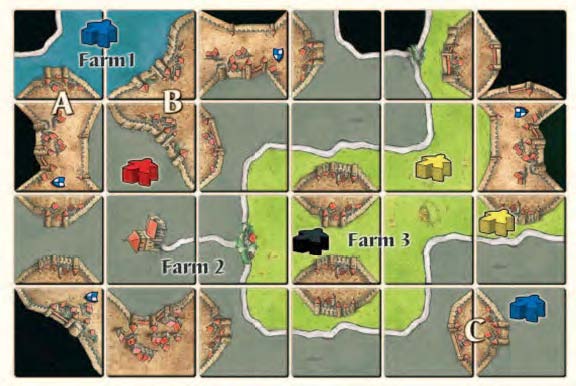
* Farm 1: BLUE owns farm 1. Two completed cities (A and B) border the farm. For each completed city BLUE scores 3 points (irrespective of their size), or a total of 6 points.
* Farm 2: RED and BLUE own farm 2. There are three completed cities (A, B and C) bordering or lying within this farm. RED and BLUE therefore score 9 points each.
Notice that cities A and B score points for BLUE on farm 1 as well as RED and BLUE on farm 2, since these cities border both farms. The city on the bottom left is incomplete, and so generates no points.
* Farm 3: YELLOW owns farm 3, since YELLOW has more farmers on it than BLACK. There are four completed cities bordering or lying within farm 3, so YELLOW scores 12 points.
Variants
There are a number of variants for the base game, which modify or redefine the rules of the game to achieve different effects. In the early years of the game, expansions were not so common and many fans started to explore alternative rules to exploit the game's potential. HiG noticed and posted many of these variants on their website for several years.
You can find more information about these variants here.
House Rules
- The players decide who starts the game by any method they choose—such as by rolling three followers. The first player to ‘roll’ a standing follower decides who plays first. (Thanks to Joff.)
- To determine the first player; each player draws a tile from the bag, the player that drew the tile with the most roads (0 to 4) plays first, if there is a tie for most roads, a draw-off takes place. This is repeated until someone wins. (Thanks to michael.)
- Take your next tile at the end of your turn, to give you time to think about placement and avoid analysis paralysis.
- Play with a three-tile hand. The abbey counts as part of your hand. Play your turn, including the builder, and then draw back up to three tiles. These tiles could be visible to all or hidden to the other players (Thanks to DavidP and youtch.)
- When playing with a bag for the tiles, the original starting tile may be put into the bag, and unplayable tiles can be put back into the bag rather than set to one side. (Thanks to dwhitworth.)
- Trees (bushes) on roads do not end the road—only houses do (when the road forks). This makes road building a lot more dynamic. (Thanks to Tobias.)
- When a tile is the only tile which can currently complete a structure, other players can offer to ‘buy’ it by offering points, trades counter, abbey, and so on. (Thanks to Deatheux.)
- If you place a tile that fills a hole in the playing field by touching something on all four adjacent sides, you get another turn. This helps motivate people to finish the board even if they do not get an advantage from the placement. (Does not apply to the abbey tile). (Thanks to viberunner.)
- Incomplete features at the end of the game do not score points at the end of the game. (Thanks to metoth.)
- The edge of the table limits the playing area. Thus, a player may not place a tile past the edge of the table or move the playing area to place a tile that would have been past the edge of the table. (Thanks to metoth for prompting this one, and to SkullOne for pointing out that this is an official rule from Hunters and Gatherers.)
- Table borders COMPLETE features as an abbey would. (Thanks to PreGy.)
- Use colored dice instead of meeples on the scoring track. Start out with the 6 showing on top. When the marker completes one lap, turn it to the number 1 to indicate it has completed one lap. This shows at a glance which player is on what lap and who's ahead. On the 100 space track it’s even easier to determine someone’s score at a glance. (Thanks to Carcking.)
Use of a Table
A number of questions have been asked about rules related to the play area itself, including what happens when the edge of the area is reached, or if a table has to be used for play. The following clarifications are from Georg Wild from HiG (5/2013):
- The edge of the table is the limit for the game if, as stated in the rules, a table is used.
- The rules state that the starting tile is placed in the middle of the table. If all of the tiles are shifted to allow more room, the starting tile would no longer be in the middle. So in principle, total shifting of the tiles is not allowed. Additionally, with a manual shift of all of the tiles, the tiles and figures on the field can slip, which could lead to incorrect positioning of tiles or figures.
- Addition of a second table is possible if one of an appropriate height is added to the first table. If a table is extended (as with an additional panel), make sure that the tiles and figures on the playing field do not slip.
- Playing on the floor: The rules technically do not allow this, because the rules state that the first tile is placed in the middle of the table. Playing on the floor is not forbidden, however, if use of a table is not feasible. If the floor is used, tiles must be placed so all tiles are visible to all players. Tiles cannot be placed under the sofa, cabinet/shelf, etc.
- It is important generally, that all the players in the round agree how to play:
- Table - Standard
- Table - with "total shifting" of tiles
- Table - with extension
- Floor
- Continue to play fairly and not intentionally unfair to other players.
Обзор квадратов
Примечания
Для лицензирования иконок и объяснения, пожалуйста, посетите страницу иконок.
- ↑
 If you complete an unoccupied feature, it is not mandatory for you to place a follower on it. If you place a follower and occupy the just completed feature, you will score points for it (and remove your follower right away). Otherwise, you will not receive points for the feature.
If you complete an unoccupied feature, it is not mandatory for you to place a follower on it. If you place a follower and occupy the just completed feature, you will score points for it (and remove your follower right away). Otherwise, you will not receive points for the feature.
- ↑
 In the game there are crossings and junctions. But since all crossings have the same effect—namely, to bring a road to an end—it was decided to sacrifice the distinction between crossings and junctions (or T-crossings, or T-roads...?) in order to not unnecessarily complicate matters.
In the game there are crossings and junctions. But since all crossings have the same effect—namely, to bring a road to an end—it was decided to sacrifice the distinction between crossings and junctions (or T-crossings, or T-roads...?) in order to not unnecessarily complicate matters.
- ↑
 The RGG edition states rather confusingly that “a city is complete when the city is completely surrounded by a city wall and there are no gaps in the wall.” Obviously, a city cannot be completely surrounded by a wall, and the wall have gaps at the same time. It is the city itself which cannot have gaps, as the HiG rules make clear.
The RGG edition states rather confusingly that “a city is complete when the city is completely surrounded by a city wall and there are no gaps in the wall.” Obviously, a city cannot be completely surrounded by a wall, and the wall have gaps at the same time. It is the city itself which cannot have gaps, as the HiG rules make clear.
- ↑
 Note that the so-called ‘small city’ rule is no longer used in any edition. This rule stated that a city of two segments—the smallest possible completed city— scored only 2 points, or 1 point per tile. Pennants in a small city also scored only 1 point each. However, small cities are now scored in the same way as every other city: that is, 2 points for every city segment, and 2 points per pennant.
Note that the so-called ‘small city’ rule is no longer used in any edition. This rule stated that a city of two segments—the smallest possible completed city— scored only 2 points, or 1 point per tile. Pennants in a small city also scored only 1 point each. However, small cities are now scored in the same way as every other city: that is, 2 points for every city segment, and 2 points per pennant.
- ↑
 Note in the box that features are considered to be complete as soon as the tile is placed, although follower placement and scoring only occur afterwards. This is important when playing with
Note in the box that features are considered to be complete as soon as the tile is placed, although follower placement and scoring only occur afterwards. This is important when playing with  Мини #1 - Летательные аппараты.
Мини #1 - Летательные аппараты.
- ↑
 Okay, “never” is a long time. In reality, some special mechanics in some expansions (
Okay, “never” is a long time. In reality, some special mechanics in some expansions ( The Festival tiles,
The Festival tiles,  Принцесса и дракон, etc.) do allow return of farmers to their owners. (12/2014)
Принцесса и дракон, etc.) do allow return of farmers to their owners. (12/2014)
- ↑
 In determining farm size, farms can be limited by all kinds of barriers, for example, roads, cities, or rivers which cannot be circumvented, or the edge of the playing field. It can certainly happen that a farm covers almost the entire playing field, and there will likely be farms that remain open for the entire game.
In determining farm size, farms can be limited by all kinds of barriers, for example, roads, cities, or rivers which cannot be circumvented, or the edge of the playing field. It can certainly happen that a farm covers almost the entire playing field, and there will likely be farms that remain open for the entire game.
- ↑
 River segments also separate farms. (08/2014)
River segments also separate farms. (08/2014)
- ↑
 The graphic here suggests that it might also be a good idea to lie the follower being used as a scoring marker flat on the scoreboard as the "50" is passed.
The graphic here suggests that it might also be a good idea to lie the follower being used as a scoring marker flat on the scoreboard as the "50" is passed.
- ↑
 This is the first real difference to previously published editions, now having its own section and a description of point tiles, which were previously considered to be a part of the
This is the first real difference to previously published editions, now having its own section and a description of point tiles, which were previously considered to be a part of the  Таверны и соборы.
Таверны и соборы.
- ↑
 Note that, according to the RGG
Note that, according to the RGG  Big Box 3 rules, the last land tile placed could be an Abbey tile. According to these most recent rules, “If one or more players have not yet placed their Abbey tiles when the last landscape tile is drawn and placed, they may now do so, if possible, in clockwise order starting from the left of the person who placed the last tile. Then, the game ends.” This is a reversal of a previous FAQ, which used the statement, “The game is over when the last face-down land tile has been played.” This older statement was to specifically prevent players from placing any abbey tiles which they may still have in their hand after the last ‘normal’ land tile (from the stack, the bag, or the dispenser) had been played.
Big Box 3 rules, the last land tile placed could be an Abbey tile. According to these most recent rules, “If one or more players have not yet placed their Abbey tiles when the last landscape tile is drawn and placed, they may now do so, if possible, in clockwise order starting from the left of the person who placed the last tile. Then, the game ends.” This is a reversal of a previous FAQ, which used the statement, “The game is over when the last face-down land tile has been played.” This older statement was to specifically prevent players from placing any abbey tiles which they may still have in their hand after the last ‘normal’ land tile (from the stack, the bag, or the dispenser) had been played.
- ↑
 This describes what is known as the "third edition" method of scoring farms, the method currently accepted by all publishers.
This describes what is known as the "third edition" method of scoring farms, the method currently accepted by all publishers.
- ↑
 Question: What are the differences to the rules of the first edition, when Carcassonne won Game of the Year? Answer: The scoring of farms was not from the perspective of the farms themselves, as it is now, but rather from the perspective of the cities. For every city, you had to check how many farmers of each color were adjacent to it, irrespective of from which side. The player with the majority of adjacent farmers supplying a city would earn four points for it. Each city would as such only be scored once, and therefore earned more points. According to the old rules, BLUE would be the only one to score points, since two of his or her farmers are supplying the cities, even though they are on different farms. YELLOW has only one farmer adjacent to the city and goes home without anything. According to the new rules, both farmers earn points; and following the most recent rule changes, BLUE even earns points twice.
Question: What are the differences to the rules of the first edition, when Carcassonne won Game of the Year? Answer: The scoring of farms was not from the perspective of the farms themselves, as it is now, but rather from the perspective of the cities. For every city, you had to check how many farmers of each color were adjacent to it, irrespective of from which side. The player with the majority of adjacent farmers supplying a city would earn four points for it. Each city would as such only be scored once, and therefore earned more points. According to the old rules, BLUE would be the only one to score points, since two of his or her farmers are supplying the cities, even though they are on different farms. YELLOW has only one farmer adjacent to the city and goes home without anything. According to the new rules, both farmers earn points; and following the most recent rule changes, BLUE even earns points twice.
- ↑
 The HiG rules do not have any instructions regarding what to do in case of a tie. The RGG rules state that tied players “rejoice in their shared victory.” The ZMG rules state, “In case of a tie, play another game to determine the winner!”
The HiG rules do not have any instructions regarding what to do in case of a tie. The RGG rules state that tied players “rejoice in their shared victory.” The ZMG rules state, “In case of a tie, play another game to determine the winner!”
- ↑

 Big Box 5 actually includes these 72 tiles with standard backs as well as a separate starter tile. Thus, there is effectively an extra tile with a city cap and a horizontal road (CRFR, see Consolidated Tile Reference) in the
Big Box 5 actually includes these 72 tiles with standard backs as well as a separate starter tile. Thus, there is effectively an extra tile with a city cap and a horizontal road (CRFR, see Consolidated Tile Reference) in the  Big Box 5 base set.
Big Box 5 base set.
